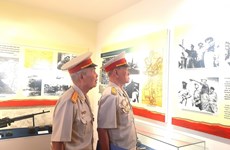Photos, items on Hung King worship rituals on display
Hundreds of photos and items on Hung King worshipping rituals and over 500 antiquities from the era of the Hung Kings (estimated around 3,000 B.C) to the 19th century are on display at Hung Vuong Museum in Viet Tri city, the northern province of Phu Tho.
 An overview of the procession ritual at 2016 Hung Kings Temple Festival (Source: VNA)
An overview of the procession ritual at 2016 Hung Kings Temple Festival (Source: VNA)The exhibition, which opened on March 29, is among a series of events in commemoration of the death anniversary of Hung Kings and the Hung King Temple Festival 2017.
According to Director of the provincial Department of Culture, Sports and Tourism Nguyen Ngoc An, the exhibited antiquities are from private collections.
They are made from different materials, such as stone, pottery and copper, for worship, decoration and domestic use purposes, he said.
Vietnamese legend has it that Lac Long Quan, son of Kinh Duong Vuong, married Au Co, daughter of King De Lai. Au Co gave birth to a sack containing 100 eggs from which 100 children were born. The couple then decided to separate to populate the land, so half the children followed their mother to the highlands and the rest went with their father to the sea.
The first child went with mother Au Co to Phong Chau, now Phu Tho province. He then became King Hung and founded the first nation in the history of Vietnam, Van Lang.
Ruling the country for 18 generations, the Hung Kings taught the people how to grow wet rice. They chose Nghia Linh Mountain, the highest in the region, to perform rituals devoted to rice and sun deities to pray for lush crops.
To honour the Hung Kings, a complex of temples dedicated to them was built on Nghia Linh Mountain, and the tenth day of the third lunar month serves as their anniversary
The worshipping rituals of the Hung Kings are closely related to the ancestral worship traditions of most Vietnamese families, an important part of people's spiritual lives. It was recognised as UNESCO Intangible Cultural Heritage of Humanity in 2012.-VNA











